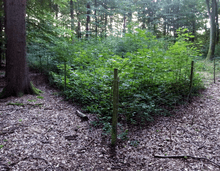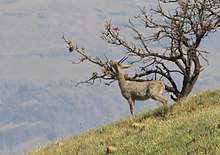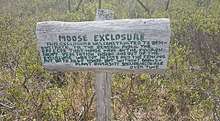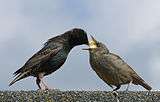Browsing (herbivory)
Browsing is a type of herbivory in which a herbivore (or, more narrowly defined, a folivore) feeds on leaves, soft shoots, or fruits of high-growing, generally woody plants such as shrubs.[1] This is contrasted with grazing, usually associated with animals feeding on grass or other low vegetation. Alternatively, grazers are animals eating mainly grass, and browsers are animals eating mainly non-grasses, which include both woody and herbaceous dicots. In either case, an example of this dichotomy are goats (which are browsers) and sheep (which are grazers); these two closely related ruminants utilize dissimilar food sources.


.jpg)
Browse
The plant material eaten is known as browse[2] and is naturally taken straight from the plant, though owners of livestock such as goats and deer may cut twigs or branches for feeding to their stock.[3] In temperate regions, owners take browse before leaf fall, then dry and store it as a winter feed supplement. In time of drought, herdsmen may cut branches from beyond the reach of their stock, as forage at ground level. In the tropical regions, where population pressure leads owners to resort to this more often, there is a danger of permanent depletion of the supply. Animals in captivity may be fed browse as a replacement for their wild food sources; in the case of pandas, the browse may consist of bunches of banana leaves, bamboo shoots, slender pine, spruce, fir and willow branches, straw and native grasses.[4]
If the population of browsers grows too high, all of the browse that they can reach may be devoured. The resulting level below which few or no leaves are found is known as the browse line.[5] If over-browsing continues for too long, the ability of the ecosystem's trees to reproduce may be impaired, as young plants cannot survive long enough to grow too tall for browsers to reach.[6]
Overbrowsing
Overbrowsing occurs when overpopulated or densely concentrated herbivores exert extreme pressure on plants, reducing the carrying capacity and altering the ecological functions of their habitat.[7][8][9] Examples of overbrowsing herbivores around the world include Koala in Southern Australia, introduced mammals in New Zealand, and cervids in forests of North America and Europe.[8][10][11]
Overview

Deer exclosures (fenced off areas) are used to determine the ecological impacts of cervids, allowing scientists to compare flora, fauna, and soil in areas inside and outside of exclosures.[10][12] Changes in plant communities in response to herbivory reflect the differential palatability of plants to the overabundant herbivore as well as the variable ability of plants to tolerate high levels of browsing.[8] Compositional and structural changes in forest vegetation can have cascading effects on the entire ecosystem including impacts on soil quality and stability, micro- and macro-invertebrates, small mammals, songbirds, and perhaps even large predators.[8][13][9][10]
Causes
There are several causes of overabundant herbivores and subsequent overbrowsing. Herbivores are introduced to landscapes in which native plants have not evolved to withstand browsing, and predators have not adapted to hunt the invading species.[9] In other cases, populations of herbivores exceed historic levels due to reduced hunting or predation pressure. For example, carnivores declined in North America throughout the last century and hunting regulations became stricter, contributing to increased cervid populations across North America.[14] Also, landscape changes due to human development, such as in agriculture and forestry, can create fragmented forest patches between which deer travel, browsing in early successional habitat at the periphery.[15] Agricultural fields and young silvicultural stands provide deer with high quality food leading to overabundance and increased browsing pressure on forest understory plants.[8]
Impacts on plants
Overbrowsing impacts plants at individual, population, and community levels. The negative effects of browsing are greater among intolerant species, such as members of the genus Trillium, which have all photosynthetic tissues and reproductive organs at the apex of a singular stem.[16] This means that a deer may eat all the reproductive and photosynthetic tissues at once, reducing the plant's height, photosynthetic capabilities, and reproductive output.[16] This is one example of how overbrowsing can lead to the loss of reproductive individuals in a population, and a lack of recruitment of young plants. Plants also differ in their palatability to herbivores. At high densities of herbivores, plants that are highly selected as browse may be missing small and large individuals from the population.[16] At the community level, intense browsing by deer in forests leads to reductions in the abundance of palatable understory herbaceous shrubs, and increases in graminoid and bryophyte abundance which are released from competition for light.[16][17][9]
Impacts on other animals
Overbrowsing can change near-ground forest structure, plant species composition, vegetation density, and leaf litter, with consequences for other forest-dwelling animals.[8] Many species of ground-dwelling invertebrates rely on near-ground vegetation cover and leaf litter layers for habitat; these invertebrates may be lost from areas with intense browsing.[18] Further, preferential selection of certain plant species by herbivores can impact invertebrates closely associated with those plants.[18] Migratory forest-dwelling songbirds depend on dense understory vegetation for nesting and foraging habitat and reductions in understory plant biomass caused by deer can lead to declines in forest songbird populations.[8][19] Finally, loss of understory plant diversity associated with ungulate overbrowsing can impact small mammals that rely on this vegetation for cover and food.[13]
Management and recovery
Overbrowsing can lead plant communities towards equilibrium states which are only reversible if herbivore numbers are greatly reduced for a sufficient period, and actions are taken to restore the original plant communities.[8] Management to reduce deer populations takes a three-pronged approach: (1) large areas of contiguous old forest with closed canopies are set aside, (2) predator populations are increased, and (3) hunting of the overabundant herbivore is increased.[8] Refugia in the form of windthrow mounds, rocky outcrops, or horizontal logs elevated above the forest floor can provide plants with substrate protected from browsing by cervids.[20][21][22] These refugia can contain a proportion of the plant community that would exist without browsing pressure, and may differ significantly from the flora found in nearby browsed areas.[20] If management efforts were to reduce cervid populations in the landscape, these refugia could serve as a model for understory recovery in the surrounding plant community.[20]
See also
- Consumer-resource systems
- Silvopasture
- Tree shelter
- Yellow-cedar decline
References
- Chapman, J.L. and Reiss, M.J., Ecology: Principles and Applications. Cambridge, U.K.: Cambridge University Press, 1999. p. 304. (via Google books, Feb 25, 2008)
- Oxford English Dictionary: Browse.
- St. John's College, Oxford: Forest Glossary: Browse, Browsewood.
- Buy a bunch of browse for the bears, Animals Asia Archived 2011-07-18 at the Wayback Machine
- Texas Parks & Wildlife, "Browsing Pressure"; accessed 2016.02.16.
- University of Pennsylvania, "Special Issue: Deer eating the future of Pennsylvania's Forests! Archived 2016-10-05 at the Wayback Machine"; accessed 2016.02.16.
- "Relationships between Introduced Black-tailed Deer and the Plant Life of the Queen Charlotte Islands, British Columbia. - Google Scholar". scholar.google.ca. Retrieved 2017-03-08.
- Côté, Steeve D.; Rooney, Thomas P.; Tremblay, Jean-Pierre; Dussault, Christian; Waller, Donald M. (2004-01-01). "Ecological Impacts of Deer Overabundance". Annual Review of Ecology, Evolution, and Systematics. 35: 113–147. doi:10.1146/annurev.ecolsys.35.021103.105725. JSTOR 30034112.
- Pojar, J., Lewis, T., Roemer, H., and Wilford, D.J. 1980. Relationships between Introduced Black-tailed Deer and the Plant Life of the Queen Charlotte Islands, British Columbia. Unpublished Manuscript, Ministry of Forests, Smithers, B.C. 63 p.
- Wardle, David A.; Barker, Gary M.; Yeates, Gregor W.; Bonner, Karen I.; Ghani, Anwar (2001-01-01). "Introduced Browsing Mammals in New Zealand Natural Forests: Aboveground and Belowground Consequences". Ecological Monographs. 71 (4): 587–614. doi:10.2307/3100037. JSTOR 3100037.
- Whisson, Desley A.; Dixon, Victoria; Taylor, Megan L.; Melzer, Alistair (2016-01-06). "Failure to Respond to Food Resource Decline Has Catastrophic Consequences for Koalas in a High-Density Population in Southern Australia". PLOS ONE. 11 (1): e0144348. Bibcode:2016PLoSO..1144348W. doi:10.1371/journal.pone.0144348. ISSN 1932-6203. PMC 4703219. PMID 26735846.
- Jordan, James S. (1967-01-01). "Deer browsing in northern hardwoods after clearcutting. Effect on height, density, and stocking of regeneration of commercial species". Res. Pap. Ne-57. Upper Darby, Pa: U. S. Department of Agriculture, Forest Service, Northeastern Forest Experiment Station. 15 P. 057.
- Flowerdew, J.R. (2001-01-01). "Impacts of woodland deer on small mammal ecology". Forestry. 74 (3): 277–287. doi:10.1093/forestry/74.3.277. ISSN 0015-752X.
- Chollet, Simon; Martin, Jean-Louis (2013-04-01). "Declining woodland birds in North America: should we blame Bambi?". Diversity and Distributions. 19 (4): 481–483. doi:10.1111/ddi.12003. ISSN 1472-4642.
- Alverson, William S.; Waller, Donald M.; Solheim, Stephen L. (1988-01-01). "Forests Too Deer: Edge Effects in Northern Wisconsin". Conservation Biology. 2 (4): 348–358. doi:10.1111/j.1523-1739.1988.tb00199.x. JSTOR 2386294.
- Augustine, David J.; Decalesta, David (2003-01-01). "Defining deer overabundance and threats to forest communities: From individual plants to landscape structure". Écoscience. 10 (4): 472–486. doi:10.1080/11956860.2003.11682795. ISSN 1195-6860.
- Chollet, Simon; Baltzinger, Christophe; Saout, Soizic Le; Martin, Jean-Louis (2013-12-01). "A better world for bryophytes? A rare and overlooked case of positive community-wide effects of browsing by overabundant deer". Écoscience. 20 (4): 352–360. doi:10.2980/20-4-3627. ISSN 1195-6860.
- Stewart, A.J.A. (2001-01-01). "The impact of deer on lowland woodland invertebrates: a review of the evidence and priorities for future research". Forestry. 74 (3): 259–270. doi:10.1093/forestry/74.3.259. ISSN 0015-752X.
- Jirinec, Vitek; Cristol, Daniel A.; Leu, Matthias (2017-05-01). "Songbird community varies with deer use in a fragmented landscape". Landscape and Urban Planning. 161: 1–9. doi:10.1016/j.landurbplan.2017.01.003.
- Chollet, Simon; Baltzinger, Christophe; Ostermann, Lukas; Saint-André, Flore; Martin, Jean-Louis (2013-02-01). "Importance for forest plant communities of refuges protecting from deer browsing". Forest Ecology and Management. 289: 470–477. doi:10.1016/j.foreco.2012.10.043.
- Kain, Morgan; Battaglia, Loretta; Royo, Alejandro; Carson, Walter P. (2011). "Over-browsing in Pennsylvania creates a depauperate forest dominated by an understory tree: Results from a 60-year-old deer exclosure". The Journal of the Torrey Botanical Society. 138 (3): 322–326. doi:10.3159/torrey-d-11-00018.1.
- Long, Zachary T.; Carson, Walter P.; Peterson, Chris J. (1998-01-01). "Can Disturbance Create Refugia from Herbivores: An Example with Hemlock Regeneration on Treefall Mounds". The Journal of the Torrey Botanical Society. 125 (2): 165–168. doi:10.2307/2997303. JSTOR 2997303.
